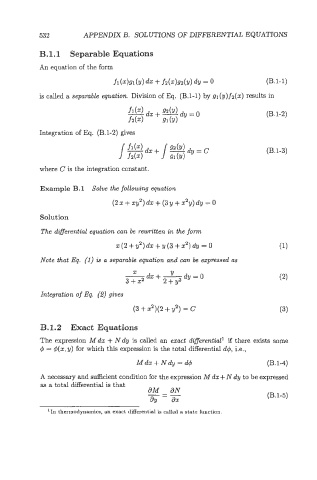Page 552 - Modelling in Transport Phenomena A Conceptual Approach
P. 552
532 APPENDIX B. SOLUTIONS OF DJFFER.ENTW EQUATIONS
B.l.l Separable Equations
An equation of the form
fl(491(Y) dz + f2(2)92(Y) dY = 0 (B.1-1)
is called a separable equation. Division of Eq. (B.1-1) by g1(y) fi(z) results in
(B.l-2)
Integration of Eq. (B.l-2) gives
(B.l-3)
where C is the integration constant.
Example B.l Solve the following equation
(22 + xy2)dz + (3y + x2y)dy = 0
Solution
The diflerential equation can be rewritten in the form
3c (2 +y2)dz + y (3 + x2) dy = 0 (1)
Note that Eq. (1) is a separable equation and can be -ressed as
z dx+ -
3+x2 2+y2 dy=O
Integration of Eq. (2) gives
(3 + z2)(2 + y2) = c
B . 1 .2 Exact Equations
The expression Mdx + Ndy is called an exact differential' if there exists some
4 = 4(x, y) for which this expression is the total differential d4, i.e.,
M dx + N dy = d4 (B. 1-4)
A necessary and Suacient condition for the expression M dx + N dy to be expressed
as a total differential is that
8M 8N
(B.l-5)
'In thermodynamics, an exact differential is called a state function.

